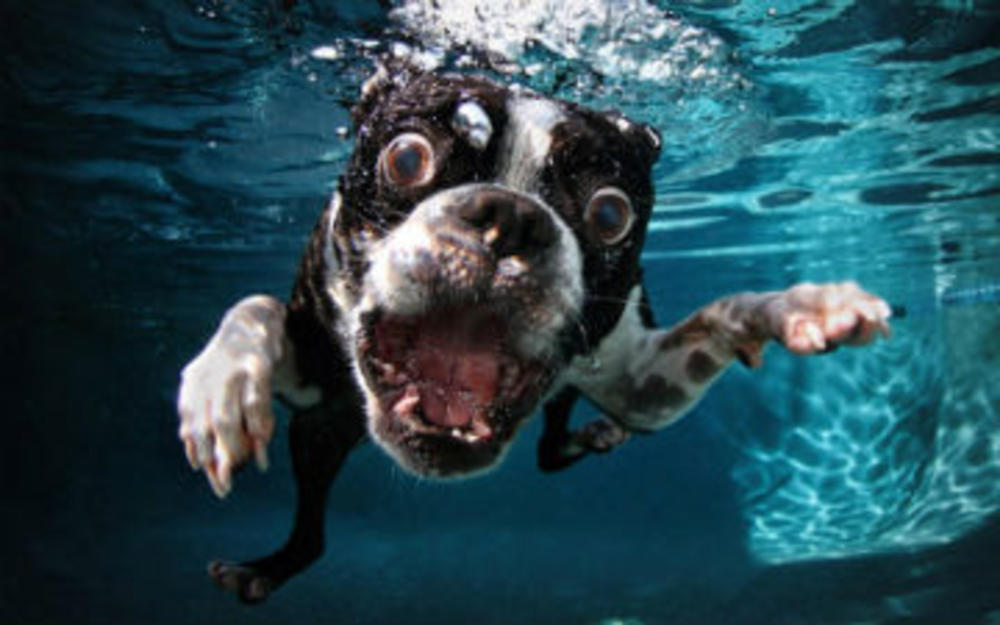Marketers love to talk about the customer journey. From awareness all the way down to advocacy, marketers can’t stop gushing about the various phases. But instead of thinking about the journey as a whole, marketers should concentrate on individual, meaningful moments, said Jeffrey Rohrs, VP of marketing insights for the Salesforce ExactTarget Marketing Cloud, speaking at the company’s Future of Marketing Tour in New York.
Take Seth Casteel, for example. Back in 2010, the photographer was snapping pictures of a Cavalier King Charles Spaniel named Buster who couldn’t resist diving into his owner’s pool to fetch his tennis ball. Casteel wondered what Buster looked like plunging into the pool from an underwater perspective. So, he spent the last available credit he had on his credit card and purchased an underwater camera housing used by pro surf photographers. The result was this:
Casteel turned his collection of photos into a coffee table book called Underwater Dogs. The book became a New York Times bestseller and led to the creation of calendars and the soon-to-be sequel Underwater Puppies.
Rohrs acknowledged that pooches have been plunging into pools for years; however, he said that Casteel identified the moment as special and monetized it—something he encourages marketers to learn how to do.
“What are the underwater dogs in your business?” he asked “How are you going to find them?”
Here are three ways marketers can find their underwater dogs (no pool required) and cash in on moments that matter.
1) Optimize known moments
Marketers need to find ways to transform consumers from passive viewers to advocates through the moments they already experience, Rohrs said. For instance, he cited how department store Nordstrom is experimenting with feeding into people’s constant need for validation by placing “popular on Pinterest” tags on select clothes, shoes, and handbags in attempts to boost sales.
Similarly, he talked about how Esurance took advantage of post-Super Bowl airtime and social media. The auto insurance provider featured a spot in which actor John Krasinski announced that the company was giving away all of the money that it saved by running its commercial after Super Bowl XLVIII—a whopping $1.5 million—to one lucky winner who tweeted #EsuranceSave30.
According to Leo Burnett, the agency that created the spot, the company received more than 224,000 mentions within the first minute after the commercial aired and gained more than 267,000 followers within 36 hours.
“All marketing is direct now because of this device,” Rohrs said pointing to his smartphone. “So why on Earth aren’t you asking people to do things?”
2) Uncover hidden moments
Sometimes the best moments are right under a marketer’s nose. “There’s a lot of stuff hiding in plain sight,” Rohrs said.
For Super Bowl XLVI, Papa John’s decided to capture America’s attention before the game even started—during the coin toss, Rohrs noted. The pizza company asked Americans to vote on whether the coin would land on “heads” or “tails” via papajohns.com before Game Day. If the majority of participants made the right call, then Papa John’s would give everyone in its reward programs a free large one-topping pizza and two-liter Pepsi MAX. Both the brand and the consumer were winners in this case. Not only did America correctly call the coin toss, and hence obtain its many free pizzas, but Papa John’s also drove people to its website.
Delta is another company taking advantage of untapped moments with its newly launched Innovation Class, Rohrs said. Innovation Class is a “mentoring program” to which people can apply through LinkedIn to sit next to leaders in business, art, and technology on a Delta flight and utilize their flight time to pick their brains. The first Innovation Class flight took place on March 14 and featured Eric Migicovsky, creator of Pebble Smartwatch.
3) Create new moments because of technology
Today’s technology allows marketers to seize opportunities they’d never even dreamed of before—but mobility, connectivity, social media, and data are helping turn those dreams into realities, noted Rohrs.
For example, Meat Pack, a small designer shoe store in Guatemala, needed to stand out against its big brand competitors in the mall and draw consumers into its store, he said. So, in 2012, the company launched the Hijack app, which used GPS technology to detect when one of Meat Pack’s customers entered a competitor’s store. Meat Pack then sent those customers an offer starting at 99% off, which decreased with each passing second. The sooner customers reached Meat Pack’s store, the higher the discount they would receive.
According to 4 am Saatchi and Saatchi Guatemala, the agency behind the initiative, more than 600 consumers were hijacked in one week. Hijack also won several Cannes Lions awards in 2012, including a silver for the creative use of technology and a bronze for mobile applications.
But a single campaign wasn’t enough for American Express. Rohrs cited how the financial services company partnered with global marketing agency Digitas to launch the first Small Business Saturday on November 27, 2010.
“American Express made an entire day matter,” he said.
Small Business Saturday is held the day after Black Friday to remind consumers to support local businesses during their holiday shopping sprees. According to Publicis Groupe, the parent company of Digitas, small business owners could take advantage of free marketing tools and geotargeted Facebook advertising to promote their first Small Business Saturday, while shoppers could post about their experiences and earn “shop small” credits.
The holiday has certainly gained momentum since its 2010 debut. Last year, consumers spent a total of $5.7 billion with local businesses on Small Business Saturday, according to the “2013 Small Business Saturday Consumer Insights Survey” by the National Federation of Independent Business and American Express.






